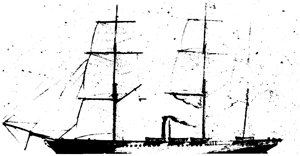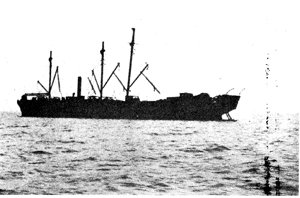The Himalaya Project
The Survey
First thing was to draw on the collective memory of the Branch divers and obtain a sketch of the wreck -before we could measure anything we needed a picture, however inaccurate to work from. This proved surprisingly difficult to obtain. After hours of diving the wreck, the report of the divers could only be said to be diverse. In the end I decided that the first dive would be to try and obtain this elusive and inaccurate picture. The divers went down with instructions to remember a small part of the wreck with rough dimensions. The result was most gratifying -at last we had something to work on.

Himalaya Sketch at Ferrybridge
During the weekend this survey took place, a group of us were chatting to some local people, and one of them mentioned seeing a sketch of the Himalaya in a boat yard at Ferrybridge. This sounded interesting, so taking Pete Shield, the Branch ace photographer, with us, we went for a look see.
The vessel depicted in the drawing was very different to the wreck we had dived on. lt was quite possible that during hulking the silhouette had changed, but the Himalaya was powered by steam as well as sail and on our wreck there was no sign of any sternshaft–the rudder was direct onto the keel as in a sailing ship. Back in Oxford, I went hunting through library and bookshop and came up with a paperback Ships -a picture history complied by Laurence Dunn, published by Piccolo. In this book there was a picture of the Himalaya together with brief history.
The Himalaya
 Himalaya as a Hulk in Portland Harbour“Himalaya ( 1853) The wonder ship of her time and by far the largest steamer afloat, the Himalaya was designed for the London–Alexandria section of the P&O Eastern mail service. She was converted from paddle to screw propulsion while building, the Admiralty having previously vetoed anything but paddles. She proved exception-ally fast, and on occasion under sail and steam she logged 16.5 knots. With the Crimean War she was first chartered and then bought to become a Naval Transport, and she continued as such until the eighties. Thereafter a coal hulk, she was bombed and sunk at Portland in 1940”
Himalaya as a Hulk in Portland Harbour“Himalaya ( 1853) The wonder ship of her time and by far the largest steamer afloat, the Himalaya was designed for the London–Alexandria section of the P&O Eastern mail service. She was converted from paddle to screw propulsion while building, the Admiralty having previously vetoed anything but paddles. She proved exception-ally fast, and on occasion under sail and steam she logged 16.5 knots. With the Crimean War she was first chartered and then bought to become a Naval Transport, and she continued as such until the eighties. Thereafter a coal hulk, she was bombed and sunk at Portland in 1940”
“Data: Owners P&O Steam Navigation Co.; Builders C.J. Mare & Co., Blackwall; Launched May 1853; Maiden voyage January 1854; Tonnage (gross) 3438 tons, (displacement) 4690 tons; Length 340ft; Breadth 46.2ft; Depth of hold 34.9ft; Draught 21Aft; Speed 14 knots; passengers 200 saloon; Engines 1 set trunk type 2050 l.h.p.; Screws one (two bladed).”
